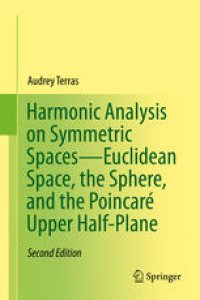
Ebook: Harmonic Analysis on Symmetric Spaces—Euclidean Space, the Sphere, and the Poincaré Upper Half-Plane
Author: Audrey Terras (auth.)
- Tags: Abstract Harmonic Analysis, Fourier Analysis, Group Theory and Generalizations, Topological Groups Lie Groups, Functions of a Complex Variable, Special Functions
- Year: 2013
- Publisher: Springer-Verlag New York
- Edition: 2
- Language: English
- pdf
This unique text is an introduction to harmonic analysis on the simplest symmetric spaces, namely Euclidean space, the sphere, and the Poincaré upper half plane. This book is intended for beginning graduate students in mathematics or researchers in physics or engineering. Written with an informal style, the book places an emphasis on motivation, concrete examples, history, and, above all, applications in mathematics, statistics, physics, and engineering.
Many corrections and updates have been incorporated in this new edition. Updates include discussions of P. Sarnak and others' work on quantum chaos, the work of T. Sunada, Marie-France Vignéras, Carolyn Gordon, and others on Mark Kac's question "Can you hear the shape of a drum?", A. Lubotzky, R. Phillips and P. Sarnak's examples of Ramanujan graphs, and, finally, the author's comparisons of continuous theory with the finite analogues.
Topics featured throughout the text include inversion formulas for Fourier transforms, central limit theorems, Poisson's summation formula and applications in crystallography and number theory, applications of spherical harmonic analysis to the hydrogen atom, the Radon transform, non-Euclidean geometry on the Poincaré upper half plane H or unit disc and applications to microwave engineering, fundamental domains in H for discrete groups Γ, tessellations of H from such discrete group actions, automorphic forms, and the Selberg trace formula and its applications in spectral theory as well as number theory.
This unique text is an introduction to harmonic analysis on the simplest symmetric spaces, namely Euclidean space, the sphere, and the Poincaré upper half plane. This book is intended for beginning graduate students in mathematics or researchers in physics or engineering. Written with an informal style, the book places an emphasis on motivation, concrete examples, history, and, above all, applications in mathematics, statistics, physics, and engineering.
Many corrections, new topics, and updates have been incorporated in this new edition. These include discussions of the work of P. Sarnak and others making progress on various conjectures on modular forms, the work of T. Sunada, Marie-France Vignéras, Carolyn Gordon, and others on Mark Kac's question "Can you hear the shape of a drum?", Ramanujan graphs, wavelets, quasicrystals, modular knots, triangle and quaternion groups, computations of Maass waveforms, and, finally, the author's comparisons of continuous theory with the finite analogues.
Topics featured throughout the text include inversion formulas for Fourier transforms, central limit theorems, Poisson's summation formula and applications in crystallography and number theory, applications of spherical harmonic analysis to the hydrogen atom, the Radon transform, non-Euclidean geometry on the Poincaré upper half plane H or unit disc and applications to microwave engineering, fundamental domains in H for discrete groups Γ, tessellations of H from such discrete group actions, automorphic forms, the Selberg trace formula and its applications in spectral theory as well as number theory.
This unique text is an introduction to harmonic analysis on the simplest symmetric spaces, namely Euclidean space, the sphere, and the Poincaré upper half plane. This book is intended for beginning graduate students in mathematics or researchers in physics or engineering. Written with an informal style, the book places an emphasis on motivation, concrete examples, history, and, above all, applications in mathematics, statistics, physics, and engineering.
Many corrections, new topics, and updates have been incorporated in this new edition. These include discussions of the work of P. Sarnak and others making progress on various conjectures on modular forms, the work of T. Sunada, Marie-France Vignéras, Carolyn Gordon, and others on Mark Kac's question "Can you hear the shape of a drum?", Ramanujan graphs, wavelets, quasicrystals, modular knots, triangle and quaternion groups, computations of Maass waveforms, and, finally, the author's comparisons of continuous theory with the finite analogues.
Topics featured throughout the text include inversion formulas for Fourier transforms, central limit theorems, Poisson's summation formula and applications in crystallography and number theory, applications of spherical harmonic analysis to the hydrogen atom, the Radon transform, non-Euclidean geometry on the Poincaré upper half plane H or unit disc and applications to microwave engineering, fundamental domains in H for discrete groups Γ, tessellations of H from such discrete group actions, automorphic forms, the Selberg trace formula and its applications in spectral theory as well as number theory.
Content:
Front Matter....Pages i-xvii
Flat Space: Fourier Analysis on ${mathbb{R}}^{m}$ ....Pages 1-106
A Compact Symmetric Space: The Sphere....Pages 107-148
The Poincaré Upper Half-Plane....Pages 149-376
Back Matter....Pages 377-413